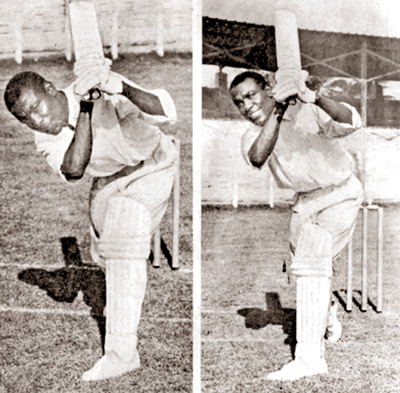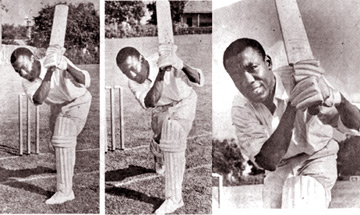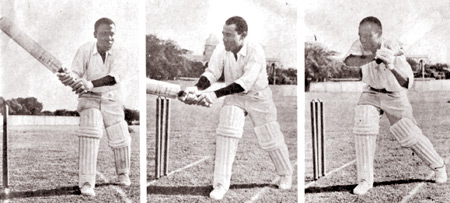|
West Indian Conrad Hunte in action...:
The Straight Drive
By A.C. De Silva
 There is no more exhilarating picture in cricket than seeing a
batsman drive the ball whether to the on or to off or to straight field.
The batsman should accept every half volley as a challenge which he is
ready and keen to meet. There is no more exhilarating picture in cricket than seeing a
batsman drive the ball whether to the on or to off or to straight field.
The batsman should accept every half volley as a challenge which he is
ready and keen to meet.
If he develops the drive he will be in a position to dictate to the
bowler, score runs for his side and, at the same time, provide
entertainment to the onlookers.
Like all true batsmen, and the West Indians in particular, especially
Conrad Hunte in particular, never forgot in the past for what purpose he
was at the wickets - to get the runs. Here are two pictures which reveal
his driving skill. Both strokes are to the back of the bowler, the
position of the left foot pointing to the exact direction to which the
ball has been driven.
The straight drive is only a continuation of the forward defensive
stroke. The bat, without stopping at the impact of the ball, is allowed
to go right through with the action of arms ending with the hands above
the left shoulder.
The stroke must be played as late as possible with the left foot
close to the pitch of the ball.
The finish of the two drives shows how ideally Hunte has picked the
ball and hit it with the full face of the bat, with arms, wrists and
hands all playing their past to impart power to the stroke.
The grin on his face shows that Hunte his happy with the drive.
The Off-Drive
 The off-drive (on Left) includes all strokes off the front foot hit
through the region from point to mid-off, any one stroke depending on
the place at which the ball has been pitched and the capacity of the
batsman to place it through a particular direction. The off-drive (on Left) includes all strokes off the front foot hit
through the region from point to mid-off, any one stroke depending on
the place at which the ball has been pitched and the capacity of the
batsman to place it through a particular direction.
The pictures on top illustrate Conrad Hunte hitting the ball between
mind-off and cover point.
The most important thing in off driving is to get the head, left
shoulder and hip over on to the line of the ball. If they are right the
left foot will look after itself. The full face of the bat must me kept
moving through the line of the stroke as long as possible.
Hunte’s placing of the feet, the turn of body and the swing of the
bat must satisfy the purist. The stroke is caught from two different
angles in the first and second pictures while the third marks the
completion, the body having risen up and the eyes fallowing the course
of the ball.
The Late Cut
 These pictures show Hunte executing one of the prettiest strokes in
Cricket – the late cut. These pictures show Hunte executing one of the prettiest strokes in
Cricket – the late cut.
The risk involved in making it and modern field placing have driven
batsmen to avoid the stroke but Hunte loved to execute it for the sheer
pleasure it gave him and the spectators. Properly done, the late cut is
as safe a stroke as any other.
On right the picture reveals that Hunte has seen the ball coming down
ideally for the cut and has started the initial movement across; in the
second he is about to bring the bat down on the ball and the third shows
the finish – the self-satisfying ‘half grin on Hunte’s face proving that
the cut has been well done. |

